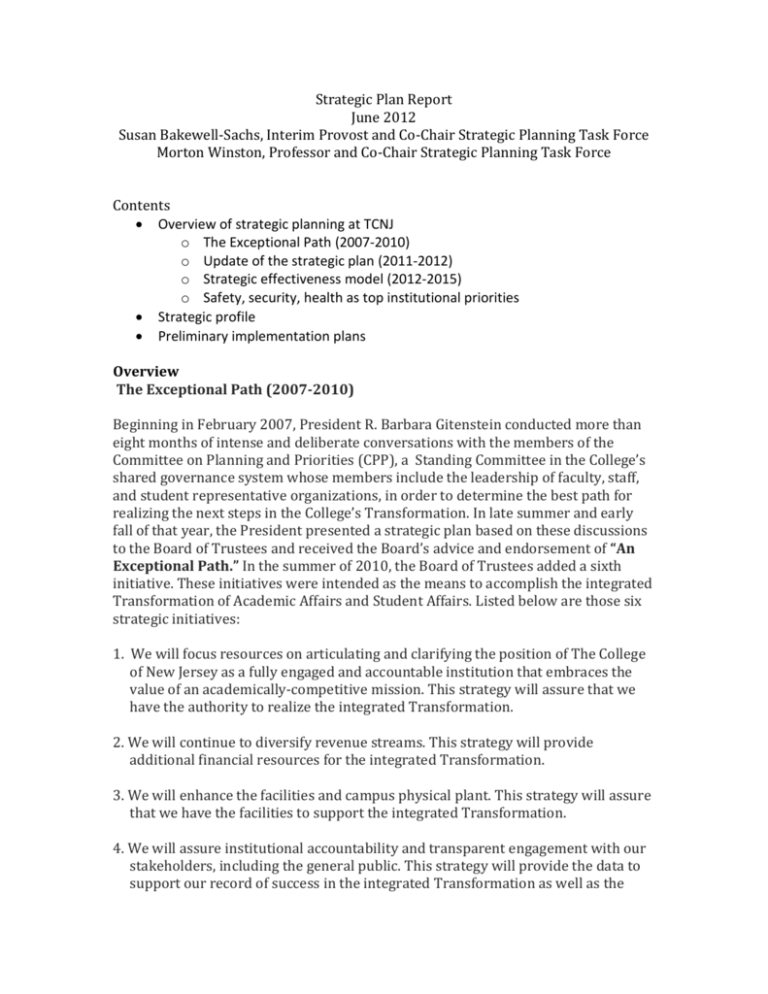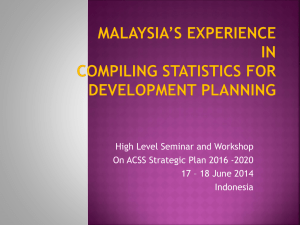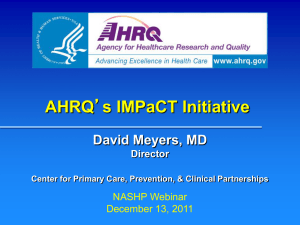Strategic Plan Report
advertisement

Strategic Plan Report June 2012 Susan Bakewell-Sachs, Interim Provost and Co-Chair Strategic Planning Task Force Morton Winston, Professor and Co-Chair Strategic Planning Task Force Contents Overview of strategic planning at TCNJ o The Exceptional Path (2007-2010) o Update of the strategic plan (2011-2012) o Strategic effectiveness model (2012-2015) o Safety, security, health as top institutional priorities Strategic profile Preliminary implementation plans Overview The Exceptional Path (2007-2010) Beginning in February 2007, President R. Barbara Gitenstein conducted more than eight months of intense and deliberate conversations with the members of the Committee on Planning and Priorities (CPP), a Standing Committee in the College’s shared governance system whose members include the leadership of faculty, staff, and student representative organizations, in order to determine the best path for realizing the next steps in the College’s Transformation. In late summer and early fall of that year, the President presented a strategic plan based on these discussions to the Board of Trustees and received the Board’s advice and endorsement of “An Exceptional Path.” In the summer of 2010, the Board of Trustees added a sixth initiative. These initiatives were intended as the means to accomplish the integrated Transformation of Academic Affairs and Student Affairs. Listed below are those six strategic initiatives: 1. We will focus resources on articulating and clarifying the position of The College of New Jersey as a fully engaged and accountable institution that embraces the value of an academically-competitive mission. This strategy will assure that we have the authority to realize the integrated Transformation. 2. We will continue to diversify revenue streams. This strategy will provide additional financial resources for the integrated Transformation. 3. We will enhance the facilities and campus physical plant. This strategy will assure that we have the facilities to support the integrated Transformation. 4. We will assure institutional accountability and transparent engagement with our stakeholders, including the general public. This strategy will provide the data to support our record of success in the integrated Transformation as well as the data to direct our aspirations to improve. 5. We will participate in the educational pipeline from pre-kindergarten to lifelong learning–P20+ discussions. This strategy will facilitate liaison with our partners in expanding access to the integrated Transformation. 6. We will enhance the educational and professional development of our faculty and staff. Update of the Strategic Plan (2011-2012) The College of New Jersey undertook a major effort during the 2011-2012 academic year to revise the strategic initiatives set forth in the “ Exceptional Path.” Expected results of the process included: An institutional document laying out a major focus and strategic areas of work, building upon the Board of Trustees’ approved six strategic initiatives, for the next several years based on input from all major constituent groups o The strategic profile included in this report provides a description of the plan. Plan development was based on focus group input from internal and external constituents and accomplished by a representative strategic planning task force with faculty, staff, students and administration. The plan builds on the “Exceptional Path.” An understanding of strategic planning and a linking of our various types and levels of planning and how they align with comprehensive strategic planning, decision making and budgeting o TSI Consulting Partners’ strategic planning definitions and four-phase process were followed to educate the community and carry out the work. The Committee on Planning and Priorities oversaw the process in their planning role and Planning Council members were engaged. A framework/methodology for strategic planning and institutional effectiveness that will provide a blueprint for implementation, evaluation/assessment and ongoing planning o Preliminary implementation plans have been developed and are included in this report. A schedule for review/adjustment and communication has been created. Consultation with Michael Middaugh will continue in fall 2012 on evaluation/assessment. An assessment plan linked to transparent communication (e.g. through the CPP planning webpage and CIE) for the campus and external communities to be able to follow progress on our strategic areas (e.g. dashboards) o The preliminary implementation plans name the expected results. Benchmarks and dashboards will be developed beginning this summer and completed by October 31, 2012. TSI Consulting Partners, Inc. Five Principles of Strategic Effectiveness Strategic effectiveness is an organization’s ability to set the right goals and consistently achieve them. Formulate Formulate Review Review&& Adjust Adjust Implement Implement Organizations with high strategic effectiveness: Quickly formulate a “good enough” strategic plan. Move immediately to implementation – letting implementation teach them the ways that the strategy is on target and ways it needs to be improved. Review progress on implementation regularly with candor and honesty. Make real-time adjustments to the strategic plan. Focus on results, not activities. Setting an Organization’s Future Direction An organization’s mission states why it exists, its reason for being, its fundamental purpose. It’s an enduring statement that usually remains the same for many years, providing long-term continuity and direction for the organization. Vision articulates the long-term outcome or end-state that the organization will make a definitive contribution to creating. Strategy outlines what the organization needs to do at this point in its history. It is more focused and time bound than mission and vision—often looking to the next three to five years. An organization’s core values and/or guiding principles outline its unique approach, its norms for “how we do things” in the organization. An organization’s tactics outline “how to” implement its strategy. The College of New Jersey Strategic Planning Process Project Overview Phase I Preparation October 2011 Phase 2 Securing Stakeholder Feedback October 2011 to January 2012 Phase 3 Strategic Planning Sessions Phase 4 Securing Feedback From Key Stakeholders February – March 2012 April – May 2012 Phases 1 through 4 were completed as per the timeline depicted above. Phase 1 – meetings were held with the Committee on Planning and Priorities, campus leaders and the strategic planning task force to introduce the overall process. Facilitators, recorders, data analysts and writers were identified and trained. Phase 2 – 22 internal focus groups with faculty, staff, students, Cabinet and Board of Trustee members were conducted. A total of more than 350 individuals participated. Two external focus groups were also conducted; one with Ewing community members and one with alumni. The focus groups were digitally recorded and summarized. The internal stakeholder feedback was analyzed and summarized into the Consolidated Internal Focus Groups Executive Summary. External focus group input was also summarized. Phase 3 – a two-day strategic planning retreat was held February 13-14, 2012. Participants represented faculty, staff, students, administration, alumni and external constituents. The result was a draft one-page strategic map with the central focus for next 3 years and 5 areas of strategic focus. Key questions discussed during the retreat included: What’s the unique value proposition TCNJ offers to students, parents and others? What is TCNJ’s distinctiveness in the world of higher education? How do we make sure we have a sustainable business model that keeps tuition affordable in support of our public mission? Phase 4 – meetings were held for all campus constituencies during which the strategic map was presented and feedback collected on three questions – what do you like about the plan? What issues or concerns do you have about the plan? What suggestions do you have to insure successful implementation of the plan? The strategic map was updated at the May 8th CPP annual retreat and an Implementation Workshop was held May 14th – 15th to draft initial implementation plans. The first year calendar for reviewing progress and adjusting and communicating the plan was also developed.








